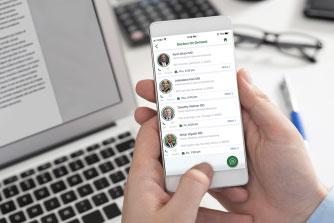Telehealth has become an increasingly familiar word during the COVID-19 pandemic. But even when it's over, telehealth will remain an essential part of health care because it helps improve access to care and offers patients and providers convenience and flexibility.
We talked with Jill Marcus, MD, a primary care physician at Rush Primary Care – Lincoln Park, and Lisa Ravindra, MD, a primary care physician at Rush Primary Care – River North, to highlight some things people might not know about telehealth.
1. Telehealth is a broad term that includes telemedicine.
Telehealth and telemedicine are often used interchangeably, and the two words are similar enough that most people will understand what you mean no matter which word you use. Both words bring to mind virtual care — care given by a provider that is conducted virtually, such as through a video conference or an online questionnaire.
But, as Marcus explains, there are important distinctions.
- Telehealth is a broad term that includes telemedicine and refers to the electronic communications and services that providers use to give patients care at a distance, that sometimes go beyond clinical care. This can be things like therapy, online video consultations, patient education videos or other general health services that a provider might offer you.
- Telemedicine, on the other hand, is a specific term that refers to the practice of providers using technology to deliver clinical care at a distance — often referred to as remote clinical services. For example, a video visit between you and your provider is telemedicine, while your provider assigning you specific patient education videos to watch is considered telehealth. Telemedicine falls under the large umbrella of telehealth.
Ravindra appreciates that video visits offer her the opportunity to discuss preventive health recommendations: “I use telehealth for both new and established patients, and it’s particularly useful to discuss mental health concerns, as those types of visits do not typically need a physical exam,” she says. “Telehealth is also useful to discuss with patients the need for preventive health screenings.”
Every provider is different when it comes to which telehealth services they prefer to offer. “Telehealth services can be used for periodic check-ins for health issues or for patients who think they have COVID-19 and need advice about what they should do,” says Marcus. “I use telehealth for my established patients who need follow-up care, or for elderly patients for whom mobility is an issue, and telehealth visits are a great supplement to their regular care.”
2. Telehealth is more than just video visits.
Most people think of video visits when they hear telehealth, but telehealth is much more than that. Telehealth can be asynchronous (not real-time) or synchronous (real-time and interactive). The type of telehealth you choose depends on your needs and what you want to get out of your telehealth encounter.
I appreciate that video visits may also allow me to see a part of a patient’s life that I wouldn’t have seen if they were in the office —it helps to increase that personal connection.
Asynchronous telehealth refers to communication with a provider through a website or mobile app. These are examples:
- MyChart messages with your provider.
- On-demand E-Visits for which you fill out a questionnaire about your health issue and receive guidance from a provider within an hour.
- Medical images that can be stored and sent to a provider who needs them, called store-and-forward. Store-and-forward is commonly used in both radiology and dermatology — like if your dermatologist needs to see a picture of a mole, they may ask you to upload a picture through their secure patient portal.
- Remote patient monitoring refers to tools that you might use to monitor your health. Remote monitoring is usually recommended by a provider and can consist of wearable heart rate monitors or blood pressure machines you might have at home or that your doctor will give you. This is common with chronic illnesses such as high blood pressure or diabetes.
- Mobile health refers to the use of mobile devices or smartphones to capture your health data. An app like MyFitnessPal or a FitBit tracker are examples of mobile health. Mobile health is usually initiated by you, but may be supported by your doctor depending on the type of app.
Synchronous telehealth, also called real-time interactive telehealth, refers to a live, interactive encounter between a patient and a health care provider over video, telephone or live chat. Examples include the following:
- On-demand video visits
- A scheduled video visit with your primary care doctor
Ravindra also appreciates that telehealth visits are convenient for both her and her patients.
“Most of the time I can address a health concern during a telehealth visit, without needing an additional in-person appointment,” she says. “Additionally, sometimes patients aren’t sure what medications or supplements they’re taking, and if we’re on a video visit, they can easily check. Patients are becoming increasingly comfortable with doing things at home — work, school and meetings, for example — so it makes sense that medical care should also be offered at home.”
3. You don’t need super high-tech equipment for telehealth.
You might think you need special equipment to use telehealth. Actually, the opposite is true: The key component for telehealth success is something most of us have access to — a computer or a smartphone/tablet.
While you don’t need high-tech equipment to use telehealth, there are some things to think about when you’re planning to use synchronous telehealth, such as a video visit. When setting up for a video visit, you should be aware of your surroundings and make sure you’re in a quiet area where you can talk freely with your provider.
Making sure your device works well is essential to having a good telehealth visit. Follow these basic tech tips to make sure you’re ready for your video visit:
• Connect to your visit using a strong Wi-Fi signal.
• Make sure your device is fully charged.
• Close other applications on your device that might be using the microphone.
• Consider using a headset or headphones to block out background noise.
At Rush, video visits work best on a smartphone or tablet. Check out our First-Time Telehealth Tips story or this tip sheet for more information on how to set up for a video visit.
4. Telehealth is for everyone.
Telehealth is being used by patients and providers across the country for routine and convenient medical care— and usage has increased dramatically over the past year because of the COVID-19 pandemic. In fact, according to NRC Health (the National Research Corporation), overall telehealth usage has nearly tripled since 2018.
Many providers at Rush, like Marcus, use telehealth regularly with their patients. “So much of medicine is about building patient-provider trust, and though a face-to-face encounter is one way to do that, I use telehealth for several clinical scenarios with many of my established patients,” says Marcus. “I typically see anywhere from one to four patients per day via telehealth.” Telehealth makes it possible for patients and providers to have that essential face-to-face contact, albeit through a screen, and helps to establish or continue a personal relationship.
Ravindra notes that telehealth helps increase access to care and can add personal connection to a patient-provider relationship. “Telehealth saves patients both time and money — if they can get care from home, they don’t need to take time off work, arrange childcare or contend with transportation if the weather happens to be bad,” says Ravindra. “I appreciate that video visits may also allow me to see a part of a patient’s life that I wouldn’t have seen if they were in the office — it helps to increase that personal connection.”
You can easily access telehealth visits at Rush with Rush On Demand. Our virtual care providers offer E-Visits and video visits for many conditions, such as cold, flu, COVID-19, allergies, rashes and more.
To get care today, click here. Just type in what’s wrong, and we’ll show you available options for care.
For more information about telehealth at Rush, check out our telehealth services page.





